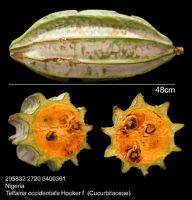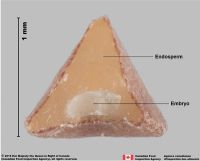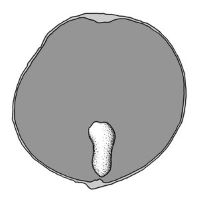Content is from Kirkbride et al. 2006Kirkbride et al. 2006:
Kirkbride JH, Jr, Gunn CR, and Dallwitz MJ. 2006. Family guide for fruits and seeds, vers. 1.0. Accessed September 2020-January 2022. URL: https://nt.ars-grin.gov/seedsfruits/keys/frsdfam/index.cfm ., without modification.
Updates are forthcoming.
Fruits: Pistil(s) compound; 1; 1-pistillate; with carpels united. Fruit pericarpium, or anthocarpanthocarp:
simple or compound and including some tissue of non-ovarian origin (accessory tissue) ; simplesimple:
; simplesimple:
fruit formed from a single flower with one pistil, solitary carpel or several fused carpels
; drupedrupe:
(indehiscent drupe) a fleshy, indehiscent fruit with one more hard pits enclosing seeds, derived from single, superior, simple or compound ovary; (dehiscent drupe) a fruit with a dry or fibrous to fleshy or leathery outer husk that early to tardily breaks apart (or opens), exposing one or more nutlike pits enclosing the seeds , or berryberry:
, or berryberry:
an indehiscent, fleshy fruit with one or a few to many seeds. The flesh may be homogenous throughout. Or, if the outer part is hard, firm, or leathery, referred to as an hesperidium. Septa are present in some, and the seeds may be arillate or with a fleshy testa. (rarely & not Spjut); simplesimple:
(rarely & not Spjut); simplesimple:
fruit formed from a single flower with one pistil, solitary carpel or several fused carpels
; glans; without persistent central column; crowned by sepals; within accessory organ(s), or not within accessory organ(s); within calyxcalyx:
the outer whorl of the perianth; all the sepals of a flower (tubilar disk), or receptacle (saucer- or cup-shaped), or pedicelpedicel:
(tubilar disk), or receptacle (saucer- or cup-shaped), or pedicelpedicel:
the stalk of a flower
(becomes swollen and fleshyfleshy:
texture—fairly firm and dense, juicy or at least moist, and easily cut
as fruit develops), or cupule; hard calyxcalyx:
the outer whorl of the perianth; all the sepals of a flower (woody); 1-seeded; 1-seeded; from 1–5 cm long (at least); 1.2–1.5 cm long; with (2–)3(–5)-carpellate; with carpels united; with carpels remaining united at maturity; with carpels not radiating at maturity; without sterilesterile:
(woody); 1-seeded; 1-seeded; from 1–5 cm long (at least); 1.2–1.5 cm long; with (2–)3(–5)-carpellate; with carpels united; with carpels remaining united at maturity; with carpels not radiating at maturity; without sterilesterile:
lacking male and/or female reproductive parts; also, not producing fruit or seed
 carpels; not sulcatesulcate:
carpels; not sulcatesulcate:
surface relief—having one or more elongate, relatively narrow and shallow depressions or grooves ; in transectiontransection:
; in transectiontransection:
a cross section; representing a plane made by cutting across an organ at a right angle to its length tereteterete:
tereteterete:
approximately circular in cross section; width and thickness approximately equal
 ; apexapex:
; apexapex:
the point farthest from the point of attachment, or the "tip" of an organ not beaked; indehiscentindehiscent:
not beaked; indehiscentindehiscent:
not opening on its own, as in a fruit
 . Epicarpepicarp:
. Epicarpepicarp:
outer layer of fruit wall or pericarp, if divided into layers; note here used synonymously with exocarp brown (all shades), or red (ish brown); durable; thinthin:
brown (all shades), or red (ish brown); durable; thinthin:
having or being of relatively little depth
; glabrousglabrous:
without hairs
; without armature; smooth, or not smooth; wrinkledwrinkled:
surface relief—shallow, irregular folds and furrows covering the surface; appearing overall though crumpled and then spread out ; without wing(s); without apicalapical:
; without wing(s); without apicalapical:
at or pertaining to the end of the seed or fruit distal from its point of attachment (i.e., base)
respiratory hole. Mesocarpmesocarp:
the middle layer of the pericarp, if divided into layers present; fleshyfleshy:
present; fleshyfleshy:
texture—fairly firm and dense, juicy or at least moist, and easily cut
, or hard; composed of 1 unified layer; without lactiform cavity system; & endocarpendocarp:
the inner layer of the pericarp, if divided into layers sharply differentiated. Endocarpendocarp:
sharply differentiated. Endocarpendocarp:
the inner layer of the pericarp, if divided into layers present, or absent; not separating from exocarpexocarp:
present, or absent; not separating from exocarpexocarp:
outer layer of fruit wall or pericarp, if divided into layers; note here used synonymously with epicarp , or separating spontaneously from exocarpexocarp:
, or separating spontaneously from exocarpexocarp:
outer layer of fruit wall or pericarp, if divided into layers; note here used synonymously with epicarp ; bonybony:
; bonybony:
very hard and rather brittle, like bone
, or crustaceouscrustaceous:
texture—thin, dry, indurate, and brittle
, or thinthin:
having or being of relatively little depth
, or fleshyfleshy:
texture—fairly firm and dense, juicy or at least moist, and easily cut
(pulpy when young, when drying becoming hard and separating from mesocarpmesocarp:
the middle layer of the pericarp, if divided into layers ), or hard; not splitting into 1-seeded pyrenes; without wing; without operculumoperculum:
), or hard; not splitting into 1-seeded pyrenes; without wing; without operculumoperculum:
a dehiscent cap (or lid) of a seed or fruit that opens during germination or dehiscence
 ; without secretory cavities; without mechanism for seedling escape; without grooves; without longitudinallongitudinal:
; without secretory cavities; without mechanism for seedling escape; without grooves; without longitudinallongitudinal:
of or relating to length or the lengthwise dimension
ridges. Funiculusfuniculus:
(alt. funicle) stalk connecting the ovule (later seed) to the ovary (later fruit) placenta short; short without seed bearing hooks (retinacula); not persisting in fruit after seed shed.
short; short without seed bearing hooks (retinacula); not persisting in fruit after seed shed.
Seeds: Arilaril:
(broad sense) appendicular structure that wholly or partly envelops a seed and is produced from or a modification of the funicle, raphe, or outer integument; usually fleshy or pulpy, sometimes spongy or tufted-capillate, often brightly colored absent. Seed minute, or larger than minute; not bowl shaped; not nutlike; without winglike beakbeak:
absent. Seed minute, or larger than minute; not bowl shaped; not nutlike; without winglike beakbeak:
a usually firm, terminal appendage, sometimes tapered ; without caudatecaudate:
; without caudatecaudate:
tapering to a long, tail-like appendage appendage(s); at maturity with food reserves; with endospermendosperm:
appendage(s); at maturity with food reserves; with endospermendosperm:
nutritive starch- and oil-containing tissue present in many seeds ; without canavanine. Sarcotestasarcotesta:
; without canavanine. Sarcotestasarcotesta:
pulpy or fleshy outer layer of the seed coat, simulates aril absent. Testatesta:
absent. Testatesta:
seed coat
 absent; crushed, or not differentiated; without embryo surrounded and capped by viscid tissue. Endospermendosperm:
absent; crushed, or not differentiated; without embryo surrounded and capped by viscid tissue. Endospermendosperm:
nutritive starch- and oil-containing tissue present in many seeds development cellular, or helobial (Mida); copious; fleshyfleshy:
development cellular, or helobial (Mida); copious; fleshyfleshy:
texture—fairly firm and dense, juicy or at least moist, and easily cut
; smooth; with starch (Thesium); with oils; without fatty acid containing cyclopropene; without apicalapical:
at or pertaining to the end of the seed or fruit distal from its point of attachment (i.e., base)
lobes; without chlorophyll; without isodiametric faceted surface; without odor. Embryo differentiated from food reserve, or undifferentiated from food reserve; well developed, or rudimentaryrudimentary:
(of embryo) embryo is small and fills less than a quarter of the seed and can be variable in shapes, such as linear, spatulate, or oval ; 1 per seed; partially filling testatesta:
; 1 per seed; partially filling testatesta:
seed coat
 (with food reserve); 0.1–0.95 times the length of food reserve; at one end of seed not extending into a depression or cup; axileaxile:
(with food reserve); 0.1–0.95 times the length of food reserve; at one end of seed not extending into a depression or cup; axileaxile:
on or of the axis
and centric; linearlinear:
(shape) long, narrow, and uniform in width; (of embryo) embryo is straight and much longer than wide ; linearlinear:
; linearlinear:
(shape) long, narrow, and uniform in width; (of embryo) embryo is straight and much longer than wide (to oblongoblong:
(to oblongoblong:
2D shape—much longer than broad with nearly parallel sides, corners are rounded ); straight; parallel to seed length; embedded in endospermendosperm:
); straight; parallel to seed length; embedded in endospermendosperm:
nutritive starch- and oil-containing tissue present in many seeds ; with cotyledons gradually connected to hypocotyl-radicle; without coleorhiza; without simmondsin; without stomata; not green; with 2 or more cotyledons, or acotyledonous. Cotyledons 2; moderately developed, or well developed; 0.3–0.7 times length of embryo; as wide as hypocotyl-radicle, or not as wide as hypocotyl-radicle; less than to 1 times wider than hypocotyl-radicle; not concealing hypocotyl-radicle; not foliaceous; thinthin:
; with cotyledons gradually connected to hypocotyl-radicle; without coleorhiza; without simmondsin; without stomata; not green; with 2 or more cotyledons, or acotyledonous. Cotyledons 2; moderately developed, or well developed; 0.3–0.7 times length of embryo; as wide as hypocotyl-radicle, or not as wide as hypocotyl-radicle; less than to 1 times wider than hypocotyl-radicle; not concealing hypocotyl-radicle; not foliaceous; thinthin:
having or being of relatively little depth
; flat; smooth; with apicesapex:
the point farthest from the point of attachment, or the "tip" of an organ entire; with margins separate; basally entire; equal in size; not punctatepunctate:
entire; with margins separate; basally entire; equal in size; not punctatepunctate:
surface relief—dotted with pits or with translucent, sunken glands or with colored dots, similar to pitted dotted. Hypocotyl-radicle moderately developed, or well developed; straight; not thickened.
dotted. Hypocotyl-radicle moderately developed, or well developed; straight; not thickened.
Mabberley: "I: Santaleae - receptacle saucer- or cupped- shaped; II: Thesieae - receptacle tubular disk; III: Anthoboleae - pedicelpedicel:
the stalk of a flower
becoming swollen and fleshyfleshy:
texture—fairly firm and dense, juicy or at least moist, and easily cut
as fruit develops".
General references: Corner, E.J.H. 1976. The seeds of Dicots, esp. vol. 2. Cambridge University Press, New York, Cronquist, A. 1981. An integrated system of classification of flowering plants, 1,262 p. Columbia University Press, New York, Engler, A. & K. Prantl. 1924 and onward. Die Natürlichen Pflanzenfamilimien. W. Engelman, Leipzig, Gaertner, J. 1788–1805. De fructibus et seminibus plantarum. The Author, Stuttgart, Goldberg, A. 1986 (dicots) & 1989 (monocots). Classification, evolution, and phylogeny of the familes of Dicotyledons. Smithsonian Contr. Bot. 58 for dicots (314 pp.) & 71 for monocots (74 pp.). [Goldberg's illustrations are reproduced from older publications and these should be consulted], Gunn, C.R. & C.A. Ritchie. 1988. Identification of disseminulesdisseminule:
detachable plant part capable of being disseminated and of propagating, commonly a seed or fruit
listed in the Federal Noxious Weed Act. Techn. Bull. U.S.D.A. 1719:1–313, Gunn, C.R., J.H. Wiersema, C.A. Ritchie, & J.H. Kirkbride, Jr. 1992 & amendments. Families and genera of Spermatophytes recognized by the Agricultural Research Service. Techn. Bull. U.S.D.A. 1796:1–500, LeMaout, E. & J. Decaisne. 1876. A general system of botany, 1,065 p. Longmans, Green, & Co., London, Mabberley, D.J. 1987. The plant-book, 706 p. Cambridge University Press, Cambridge, and Spjut, R.W. 1994. A systematic treatment of fruit types. Mem. New York Bot. Gard. 70:1–182.